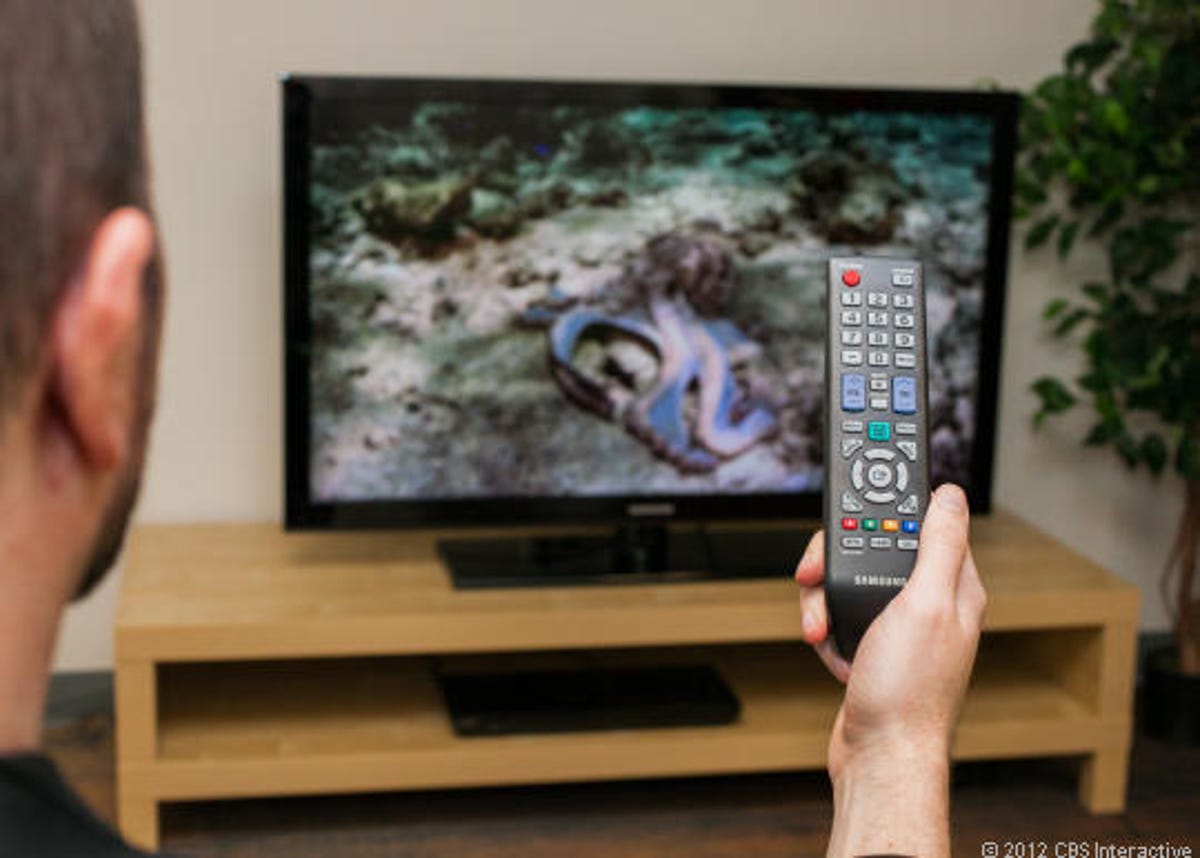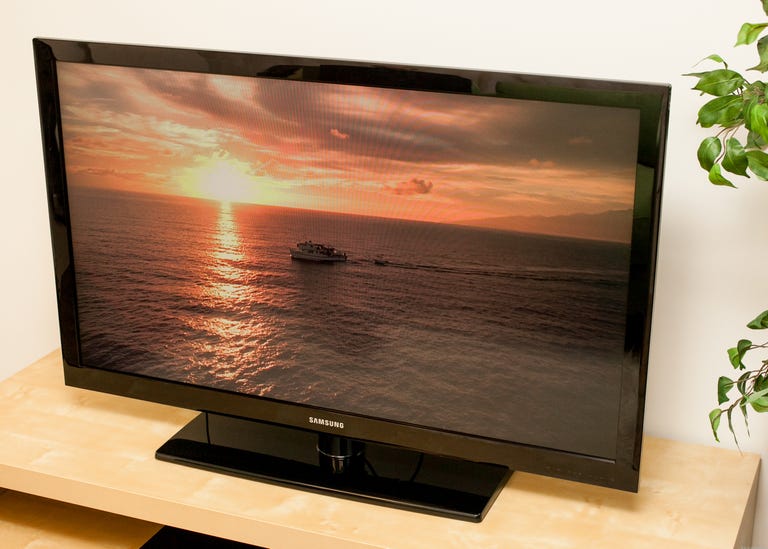 Why You Can Trust CNET
Why You Can Trust CNET Samsung E550 review: Budget TV done in by soft images
Black levels and shadow detail are pluses, but image softness in this LCD set holds it back.
Samsung has long been the leader in U.S. TV market share, but the manufacturer is facing some tough competition, especially at the budget end. Lesser-known competitors like Vizio and TCL are coming up with TVs that can challenge the Korean behemoth's picture quality at half the price.
The Good
The Bad
The Bottom Line
The Samsung E550 is a decent television with fairly deep blacks for a budget TV and bright, natural colors. Off-axis performance is very good, making it suitable for wide rooms, and the TV has excellent uniformity, making dark scenes easy to watch. Only a slight softness -- particularly to movement -- tarnishes an otherwise solid performance.
There are two TVs in the E550 range, a 40-inch and the 46-inch; the smaller model looks like the better deal at the time of review. If you're looking to spend this amount of money, though, there are plenty of other options, including the surprisingly good and much less expensive TCL P60.
| Models in series (details) | ||||
| Samsung LN40E550 | 40 inches | |||
| Samsung LN46E550 | 46 inches | |||

Design
While Samsung's TV looks black in the pictures above, it actually isn't. The bezel uses something like Samsung's old Touch of Color design, which infuses the plastic with a faint puce glow. The TV sits on a solid stand but unfortunately, it doesn't swivel.
The remote control is a little older-looking but quite usable.
The television's menu system is straightforward and easy to use; it shares the same look as the TVs I've seen over the years.
| Key TV features | ||||
| Display technology | LCD | LED backlight | N/A | |
| Screen finish | Matte | Remote | Standard | |
| Smart TV | No | Internet connection | N/A | |
| 3D technology | No | 3D glasses included | No | |
| Refresh rate(s) | 60Hz | Dejudder (smooth) processing | No | |
| DLNA-compliant | No | USB | Photo/Music/Video | |
| Other: | ||||
Features
If you're paying less than $500 for a television, you can't complain about lack of features. In Samsung's case this is often a good thing as it usually means your money not wasted on frivolities. The backlight, unlike pretty much every other 2012 Samsung TV, uses old-school fluorescents and not LEDs -- not that that matters much for picture quality.
The TV does include a Clear Motion Rate of 60 according to the specifications, but this is really just a way to invent a tick box where there wasn't one before. What it really means is that the E550 has the standard 60Hz refresh rate without smoothing of any kind.
Although it doesn't have Smart TV, the E550 does offer photo viewing and music playback via the USB port.
Picture settings: The TV boasts just three modes -- Standard, Vivid, and Movie -- and lacks the gaming-specific options of competitors like Vizio and Philips. Properly adjusted, advanced white-balance controls help ensure a better picture. The TV does miss a color management system, though, and as a result its colors aren't as accurate as they could be.
Connectivity: This TV isn't a direct replacement of the D550 and nowhere is this more obvious than in the number of connections provided. The D550 had four HDMI ports, two components, and an Ethernet port. In comparison, the inclusion of only a pair of HDMI ports seems stingy, as does the shared component/composite port. If you're looking to use the TV as a PC monitor, you'll have to use one of the HDMI inputs, as it lacks a RGB port. Also missing is a digital audio output for connection to an external amp.
Picture quality
Last year's Samsung D630 was one of our favorite budget LCDs. Here was a TV with dated styling and old-hat fluorescent lighting, but it was one of the best TVs at the price. While there are some similarities between it and the newer E550, the successor can't quite live up to the former's performance.
The Samsung E550 does offer fairly deep blacks for an LCD at the price, as well as saturated, natural colors. In cheaper sets one of the oft-compromised picture qualities is shadow detail, but here on the E550 it's one of the TV's best qualities. The E550 is able to make sense of darker scenes, placing figures in a 3D space in a way its LCD competition isn't able to. It's dark-room performance is also complemented by very good lit-room performance -- it's quite the all-rounder.
Where the TV falters is in picture detail and movement. The Samsung E550 suffers from a slight softness which could be attributed to the kind of LCD panel the company has used and/or the TV's onboard processor.
Click the image at the right to see the picture settings used in the review and to read more about how this TV’s picture controls worked during calibration.
| Comparison models (details) | ||||
| LG 47SL4600 | 47-inch LCD | |||
| LG 42CS560 | 42-inch LCD | |||
| TCL L40FHDP60 | 40-inch LCD | |||
| Samsung LN46D630 | 46-inch LCD | |||
| Toshiba 40E220U | 40-inch LCD | |||
| Panasonic TC-P65VT50 (reference) | 65-inch plasma | |||
Black level: If there was one thing the Samsung does right over everything else it's contrast. Whether it was portraying the inky depths of space in "Star Trek" or the contours and depth of a dramatically lit face, the Samsung was anything but adrift. Yes, the Toshiba E220 and last year's Samsung D630 were better overall for absolute blacks, but the E550 was better than both for shadow detail.
At the 28-minute mark of "Star Trek," the Samsung gave a reasonable approximation of the Romulan mining ship, and it was the best at reproducing the next scene which is baddie Nero's face lying on a green slab. The texture of the slab was most discernible on the Samsung with a sense that he was lying on something. On the other TVs, especially the LGs, it seemed that his head simply bled into darkness with no separation at all. Despite the Toshiba coming ultimately out on top in terms of black level, it and the Samsung were very close at times, with one TV doing one scene well and then seemingly taking turns with the other.
Color accuracy: While not as vivid as the neighboring Toshiba E220, the Samsung E550 was capable of strong color performance. Whether it was the cool blues of snowy slopes or green, lush gardens, the Samsung was able to convey color quite well. It may not offer the same level as the D630, but it was regardless a good communicator.
While I was able to get secondaries to look natural with some judicious tweaking of the Tint control, the primary colors were a little off, with reds being the most noticeable with a more maroon look to the Star Trek cadet uniforms than was noticeable on other TVs. Skin tones, while a little muted, were still fine and the Samsung was one of the better TVs in the lineup for this.
Video processing: Picture processing is the single area where this TV could have used some improvement -- it failed every synthetic test I threw at it. As expected from a 60Hz TV, there was significant judder in the 24p test. There was also plenty of lost detail in movement -- both with the Film test and the motion-resolution test.
Usually these sort of synthetic tests don't translate directly to real-world effects, but this case might be an exception. The TV has a softness to its picture that can't be remedied with use of the Sharpness control. Usually LCD blur is something you can't see, but in the case of the Samsung, leading edges lack the crispness you'll see on even cheaper TVs like the TCL and Toshiba.
Uniformity: It is here is where the otherwise superior Toshiba E220 falls apart in relation to the Samsung E550. The Samsung showed very good uniformity with no discernible light leakage with consistent black levels across the screen. The Toshiba had two noticeable spotlights in the top right-hand corners, but it wasn't the worst offender in our test. To be blunt, the two LG TVs were appalling with big, crater-size watermarks in the middle of each screen. In short, if you do a lot of watching TV in the dark, the Samsung is a very good option for that.
Off-axis performance was the best of the bunch, with only minimal color shift and bluing of blacks. While its small size means that off-axis viewing will only be useful from a few feet away, it still gets a tick from me.
Bright lighting: The Samsung had the most matte screen of the bunch, and so reflections from people in the room and indirect light sources weren't an issue. While the two LGs had blue blacks in the light, the Samsung held its color well, and still showed that impressive shadow detail I'd seen in a darkened cinema environment.
| GEEK BOX: Test | Result | Score |
|---|---|---|
| Black luminance (0%) | 0.0027 | Good |
| Avg. gamma | 2.2875 | Good |
| Near-black x/y (5%) | 0.2489/0.2442 | Poor |
| Dark gray x/y (20%) | 0.3122/0.331 | Good |
| Bright gray x/y (70%) | 0.3106/0.328 | Good |
| Before avg. color temp. | 7520.7146 | Poor |
| After avg. color temp. | 6559.117 | Good |
| Red lum. error (de94_L) | 8.6892 | Poor |
| Green lum. error (de94_L) | 8.3106 | Poor |
| Blue lum. error (de94_L) | 20.1084 | Poor |
| Cyan hue x/y | 0.2179/0.333 | Good |
| Magenta hue x/y | 0.3324/0.1465 | Average |
| Yellow hue x/y | 0.4066/0.4759 | Poor |
| 1080p/24 Cadence (IAL) | Fail | Poor |
| 1080i Deinterlacing (film) | Fail | Poor |
| Motion resolution (max) | 310 | Poor |
| Motion resolution (dejudder off) | 310 | Poor |



